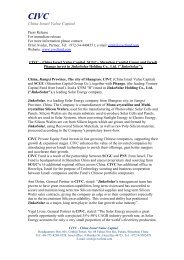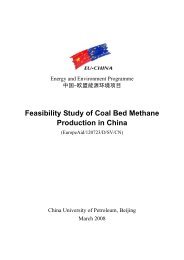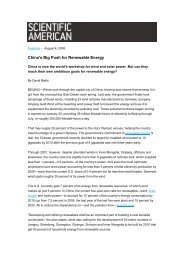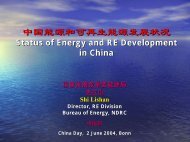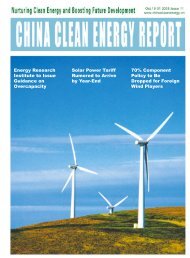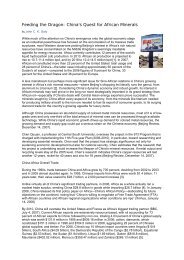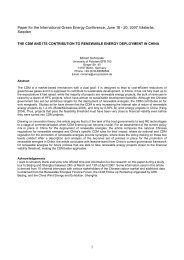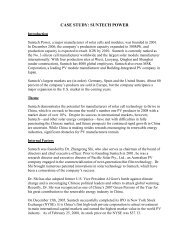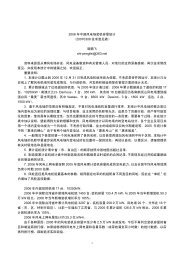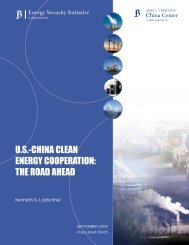LDK Solar Co., Ltd. - Asia Europe Clean Energy (Solar) Advisory Co ...
LDK Solar Co., Ltd. - Asia Europe Clean Energy (Solar) Advisory Co ...
LDK Solar Co., Ltd. - Asia Europe Clean Energy (Solar) Advisory Co ...
Create successful ePaper yourself
Turn your PDF publications into a flip-book with our unique Google optimized e-Paper software.
module production will increase from 1.5 gigawatts in 2005 to 12.0 gigawatts in 2010, representing a<br />
compound annual growth rate of 51.6%.<br />
Global Annual Crystalline Silicon-Based <strong>Solar</strong> Cell/Module Production<br />
Gigawatts<br />
14<br />
12<br />
10<br />
8<br />
6<br />
4<br />
1.5<br />
2<br />
0<br />
Source: Photon International<br />
Key growth drivers<br />
2.3<br />
3.2<br />
2005 2006 2007 2008 2009 2010<br />
We believe the following factors will continue to drive the global demand in the photovoltaic industry:<br />
Rising Prices of <strong>Co</strong>nventional <strong>Energy</strong> Sources. According to The International <strong>Energy</strong> Agency's<br />
estimate, approximately 80% of the world's electricity in 2004 was generated from fossil fuels such as coal, oil<br />
and natural gas. According to the United States Department of <strong>Energy</strong>'s International <strong>Energy</strong> Outlook,<br />
worldwide demand for electricity is projected to increase from 14.8 trillion kilowatt hours in 2003 to 30.1<br />
trillion kilowatt hours by 2030. The prices of conventional energy sources, including oil, gas and coal, have<br />
been steadily increasing in recent years. A more sustainable energy source is needed to address price increases<br />
of conventional/fossil fuel energy sources given the limited nature of fossil fuel supply and escalating<br />
electricity consumption.<br />
Government Incentives for Renewable <strong>Energy</strong> Sources. Governments around the world are implementing<br />
renewable energy policies to encourage the use of clean and sustainable energy sources, such as solar<br />
energy that does not consume any fuel and produces no pollution during operation. Use of solar power has<br />
been growing at a fast pace in countries where incentives are offered by their governments to encourage its use.<br />
<strong>Co</strong>untries such as Australia, China, Germany, Japan, Korea, Spain and the United States have offered or plan<br />
to offer substantial incentives in the form of direct subsidies for solar power system installations or rebates for<br />
electricity produced from solar power. Increasing government support for solar energy in regions, such as<br />
California and southern <strong>Europe</strong>, which receive many hours of sunlight and where solar energy is more cost<br />
competitive, is also driving demand.<br />
Tightening of Environmental Regulations. <strong>Solar</strong> power is capable of generating electricity without<br />
producing pollution such as gaseous or water emissions or noise during operation. Governments around the<br />
world are adopting initiatives aimed at addressing worldwide environmental concerns and climate change risks<br />
associated with the use of fossil fuel. Problems such as greenhouse gas emissions are being addressed by<br />
initiatives such as the United Nations Kyoto Protocol and many national and regional air pollution regulations.<br />
Increasing <strong>Co</strong>st <strong>Co</strong>mpetitiveness of <strong>Solar</strong> <strong>Energy</strong>. According to Photon <strong>Co</strong>nsulting, the average prices<br />
of solar cells and modules are expected to decrease over the next few years as a result of improved production<br />
technologies and manufacturers attaining economies of scale. Accelerated aging tests have also shown that<br />
solar modules can operate for 30 years or more without the need for major maintenance other than the<br />
cleaning of module surfaces, making them inexpensive and reliable to operate. <strong>Solar</strong> power systems are also<br />
more cost-effective for use in remote rural applications, where grid-connection costs are prohibitive. A<br />
combination of these factors is increasing solar energy's cost competitiveness compared with other alternative<br />
energy sources.<br />
68<br />
5.0<br />
8.1<br />
12.0



